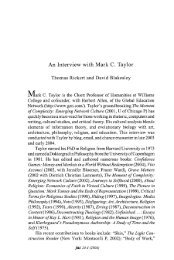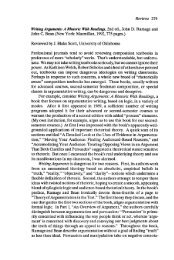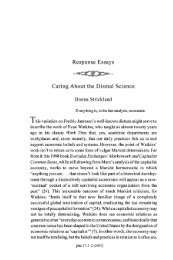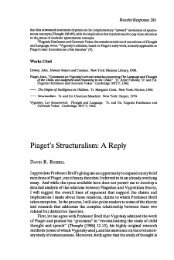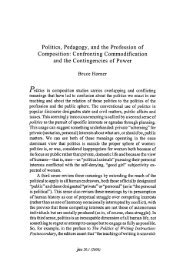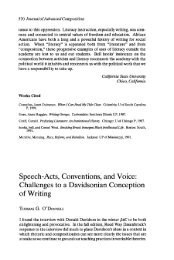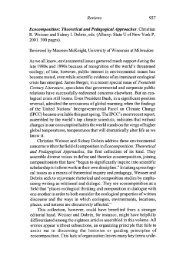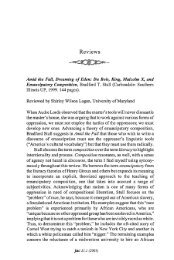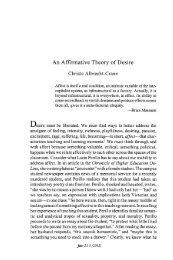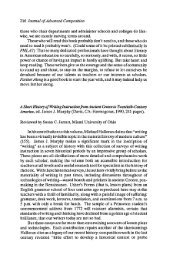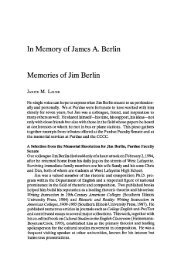Narrative Topic and the Contemporary Science Essay ... - JAC Online
Narrative Topic and the Contemporary Science Essay ... - JAC Online
Narrative Topic and the Contemporary Science Essay ... - JAC Online
Create successful ePaper yourself
Turn your PDF publications into a flip-book with our unique Google optimized e-Paper software.
<strong>Narrative</strong> <strong>Topic</strong> <strong>and</strong> <strong>the</strong><br />
<strong>Contemporary</strong> <strong>Science</strong> <strong>Essay</strong>:<br />
A Lesson from Loren Eiseley's<br />
Notebooks<br />
JOSEPH J. COMPRONE<br />
The 1970s were supposed to have moved composition teachers beyond<br />
<strong>the</strong> mechanical, mode-oriented models of <strong>the</strong> early twentieth <strong>and</strong> late<br />
nineteenth centuries. The <strong>the</strong>oretical work of James Kinneavy <strong>and</strong> Frank<br />
D' Angelo, <strong>and</strong> <strong>the</strong> historical revisionism of James Berlin <strong>and</strong> Robert Connors,<br />
have combined to encourage writing instructors to use a more purposeoriented<br />
rhetoric. l Recently, however, this healthy reaction against mechanical<br />
imitation of patterns or modes of writing has been somewhat undercut by<br />
<strong>the</strong> writing-across-<strong>the</strong>-curriculum (WAC) movement. WAC courses attempt<br />
to expose students to representative writers from <strong>the</strong> natural <strong>and</strong> social<br />
sciences as well as <strong>the</strong> humanities; but because many textbook writers <strong>and</strong><br />
teachers do not know <strong>the</strong> aims of science writing as well as <strong>the</strong>y do those of<br />
<strong>the</strong> humanities essay, <strong>the</strong> texts <strong>and</strong> assignments <strong>the</strong>y produce often return to<br />
<strong>the</strong> mechanical classifications of mode <strong>and</strong> surface pattern that were characteristic<br />
of composition readers published prior to 1970. 2 In this essay, I wish<br />
to suggest two shifts in perspective-one <strong>the</strong>oretical, <strong>the</strong> o<strong>the</strong>r practical-that<br />
I believe will help tum WAC courses toward aim <strong>and</strong> away from mode as a<br />
central organizing principle.<br />
Plural Textuality <strong>and</strong> <strong>the</strong> <strong>Science</strong> <strong>Essay</strong><br />
To establish a <strong>the</strong>oretical foundation, I wish to take a cue from <strong>the</strong> early<br />
work of Frank D' Angelo <strong>and</strong> Kenneth Burke. In A Conceptual Theory of<br />
Rhetoric, D' Angelo argues that what writing teachers call' 'patterns' , in tex ts<br />
(exposition, description, narration, comparison, <strong>and</strong> <strong>the</strong> like) are better<br />
understood as Aristotelian topics than as modes. Writers, D' Angelo asserts,<br />
actually use <strong>the</strong>se topics to generate <strong>and</strong> shape discourse as it is produced, not<br />
as empty containers to be filled with content. Yet, mode-oriented teachers use<br />
<strong>the</strong>' 'empty container" model as a basis for <strong>the</strong>ir teaching. For example,<br />
students are told to look at comparison essays, to identify <strong>the</strong> forms a<br />
particular essayist used to accomplish a comparison, <strong>and</strong> <strong>the</strong>n imitate that<br />
formal pattern, supplying <strong>the</strong>ir own content. D'Angelo argues, in contrast,
The <strong>Contemporary</strong> <strong>Science</strong> <strong>Essay</strong> 113<br />
that students should be asked to use <strong>the</strong>se forms to generate content, as topics,<br />
or places to go for new ways to express content.<br />
But we need to take D' Angelo's cue a step fur<strong>the</strong>r if we are to resolve <strong>the</strong><br />
WAC problem as I have described it. In A Grammar of Motives, Kenneth<br />
Burke supplies <strong>the</strong> <strong>the</strong>ory we need to complete this shift from mode to topic.<br />
Burke replaces Aristotle's definition of topics as places to go for traditional<br />
information <strong>and</strong> conventional wisdom with a more psychological perspective.<br />
For Burke, all discourse, scientific or literary, occurs within a dramatic<br />
context. As interpreters or critics, we do not search out intentions as if <strong>the</strong>y<br />
were static entities, existing separate from human conceptual <strong>and</strong> social<br />
processes. Ra<strong>the</strong>r, Burke asserts, we must look at intentionality as a dynamic<br />
social-psychological process, with human agents working <strong>the</strong>ir ideas out<br />
within vital dramatic contexts in which texts take on <strong>the</strong> colorings of writer,<br />
discourse community, <strong>and</strong> o<strong>the</strong>r texts. Burke's pentad is his way of describing<br />
<strong>the</strong> writing <strong>and</strong> reading of texts as a process of shifting dramatic<br />
perspective, alternatively focusing on individual, social, contextual, <strong>and</strong><br />
psychological perspectives.<br />
The concept of plural textuality, of each text containing within itself<br />
elements of o<strong>the</strong>r texts, is relevant to <strong>the</strong> practical perspective on texts that<br />
teachers need to consider in WAC courses. To demonstrate my point, I will<br />
single out one writer, Loren Eiseley, because he is representative of an<br />
exp<strong>and</strong>ing group of writers whom I shall call •• science essayists." These<br />
writers can help bring plural texts into <strong>the</strong> WAC course because <strong>the</strong>ir texts<br />
combine <strong>the</strong> textual paradigms of <strong>the</strong> sciences <strong>and</strong> humanities. That is, <strong>the</strong>y<br />
combine scientific vocabulary <strong>and</strong> inductive <strong>and</strong> deductive logic with frequent<br />
moves into narration <strong>and</strong> description <strong>and</strong> <strong>the</strong> use of literary figures <strong>and</strong><br />
schemes. It is as if <strong>the</strong>se professional scientists, in striving to translate science<br />
for <strong>the</strong> educated layperson, have been driven by context <strong>and</strong> purpose to create<br />
hybrid or plural texts.<br />
Several contemporary science essayists (Stephen Jay Gould, Oliver<br />
Sacks, Lewis Thomas, for example) base <strong>the</strong>ir texts on a marriage of story <strong>and</strong><br />
exposition, <strong>and</strong> composition <strong>the</strong>orists recently have begun to analyze <strong>the</strong><br />
complex ways that expository <strong>and</strong> narrative forms interact in <strong>the</strong>se science<br />
essays.3 This formal interaction affects readers in complex ways, turning <strong>the</strong><br />
scientist's reliance on a discipline's body of knowledge, vocabulary, <strong>and</strong><br />
methodology into <strong>the</strong> stuff of story <strong>and</strong> myth. For example, Gould <strong>and</strong><br />
Eiseley transform <strong>the</strong> history of evolution into an adventure story parallel in<br />
emotional impact <strong>and</strong> literary imagination to <strong>the</strong> Genesis story in <strong>the</strong> Bible.<br />
Such writers are, in effect, re-making our collective psychology by providing<br />
an emotional base for <strong>the</strong> sober deductive <strong>and</strong> inductive findings of science.<br />
Perhaps Gould's <strong>and</strong> 'Eiseley's combination of forms is <strong>the</strong> surface<br />
representation of deeper <strong>and</strong> equally new ways of thinking. For <strong>the</strong>se science<br />
essayists, story has become a way of knowing <strong>and</strong> inventing material, a place<br />
to find content <strong>and</strong> structure. Imagine Loren Eiseley hard at work on a field
114 Journal of Advanced Composition<br />
trip, bone-collecting on <strong>the</strong> prairie or Dakota badl<strong>and</strong>s, <strong>the</strong>n later sitting down<br />
to write about his findings <strong>and</strong> observations. Certainly, as a professional<br />
scientist (he taught at <strong>the</strong> Universities of Kansas <strong>and</strong> Pennsylvania), Eiseley<br />
had to perfonn <strong>the</strong> ordinary work of science: <strong>the</strong> careful notebook entries,<br />
field logs, research reports, professional articles, <strong>and</strong> grant requests. However,<br />
Eiseley had, as he wrote, ano<strong>the</strong>r impulse-an impulse to make a story<br />
of what he found, to fit <strong>the</strong> particulars located in his fossils <strong>and</strong> observations<br />
of nature into a larger, narrative picture of natural evolution, of life <strong>and</strong> this<br />
planet always in a state of becoming. He, in o<strong>the</strong>r words, first went to<br />
narrative <strong>and</strong> story not as a fonn to contain his content but as a place, a topic,<br />
through which his findings might be renewed <strong>and</strong> given larger significance.<br />
The scientist's commitment to fact <strong>and</strong> observation never flagged; his desire<br />
to be a professional in methodology <strong>and</strong> knowledge never decreased. But his<br />
many books of popular prose <strong>and</strong> poetry indicate that this narrative impulse<br />
gradually subsumed all that he did. In <strong>the</strong> story topic, Eiseley connects with<br />
his readers' need (to use Robert Frost's phrase) to become "whole again,<br />
beyond confusion."<br />
Eiseley's Rhetorical Motives<br />
Eiseley's reliance on narrative dem<strong>and</strong>s that wefirst examine his motives<br />
for devoting so much writing space to <strong>the</strong> narrative topic. In <strong>the</strong> Burkean<br />
sense, I propose two rhetorical motives as psychological influences on<br />
Eiseley <strong>the</strong> literary scientist.<br />
First, Eiseley's complete dedication to <strong>the</strong> paleontologist's <strong>and</strong> anthropologist's<br />
inductive <strong>and</strong> deductive methods seems always to be fraught with<br />
a writer's need to communicate, to transform <strong>the</strong> data <strong>and</strong> hypo<strong>the</strong>ses<br />
ga<strong>the</strong>red from his observations (gleaned from field trips or laboratory<br />
experiments) into ideas that intelligent laypersons can comprehend. And for<br />
Eiseley comprehension means that <strong>the</strong>se readers are able to make connections<br />
between specific scientific phenomena <strong>and</strong> more general ideas about <strong>the</strong><br />
origin <strong>and</strong> development of nature <strong>and</strong> <strong>the</strong> story of human species. Eiseley had<br />
developed <strong>the</strong> data for this kind of essay writing during his earlier explorations<br />
of Western plains terrain <strong>and</strong> from his analyses of professional <strong>and</strong><br />
public reaction to specific cultural events-<strong>the</strong> Piltdown Man hoax, <strong>the</strong> bigbang<br />
<strong>the</strong>ory, <strong>and</strong> o<strong>the</strong>r popular controversies. 4 Consider <strong>the</strong>se citations from<br />
Eiseley's recently published Lost Notebooks:<br />
September 1,1955<br />
It occurs to me that <strong>the</strong>re is a very clear analogy between <strong>the</strong> way in which an<br />
apartment house (or ano<strong>the</strong>r building, for that matter) acquires its biota <strong>and</strong><br />
<strong>the</strong> wayan oceanic isl<strong>and</strong> acquires its plant <strong>and</strong> animal popUlation. An<br />
apartment house newly built (a recent volcanic isl<strong>and</strong> upthrust from <strong>the</strong><br />
waves) is destitute at first of a fauna. If it is remote from neighborhoods where<br />
such a fauna may be acquired (isl<strong>and</strong>s far at sea), it may be destitute of insects,
The <strong>Contemporary</strong> <strong>Science</strong> <strong>Essay</strong> 115<br />
silverfish, etc., for a longer period. As time runs on, however, <strong>the</strong> chance of<br />
immigrants arriving intensifies. A pair of roaches may arrive in a box (floating<br />
timber) <strong>and</strong> escape into <strong>the</strong> basement, <strong>and</strong> soon <strong>the</strong> house is populated so<br />
extensively that even <strong>the</strong> professional exterminators can only keep <strong>the</strong><br />
population reduced. [How close] <strong>the</strong> apartment house may lie to o<strong>the</strong>r older<br />
ones or to neighborhood groceries, as in, say, New York, will playa part in <strong>the</strong><br />
time involved before population is acquired. Now, to give this a figurative<br />
evolutionary twist, we might imagine each house more self-contained than it<br />
actually is <strong>and</strong> lasting over more than one geological period ... Let us say that<br />
in one house roaches have grown adjusted to a given poison, in ano<strong>the</strong>r <strong>the</strong>y<br />
have developed clever adaptations for evading <strong>the</strong> traps set for <strong>the</strong>m by people,<br />
or perhaps o<strong>the</strong>r insects have been introduced to combat <strong>the</strong>m. Say, spiders.<br />
(92)<br />
May, 1956<br />
Four hundred million years have passed since <strong>the</strong> vertebrates fought on <strong>the</strong><br />
sea floor. They were <strong>the</strong> last of <strong>the</strong> great animal phyla (groups) to appear, <strong>and</strong><br />
if any creature below <strong>the</strong> tides knows <strong>the</strong> place of <strong>the</strong>ir origin it is <strong>the</strong> starfish.<br />
Or it may be that dark, magnificent-lensed octopod eye remembers us. He is<br />
older than we <strong>and</strong> has changed less. He was <strong>the</strong>re when we squirmed in <strong>the</strong><br />
mud, when our mouths were jawless, when our spine was a rubbery rod, <strong>and</strong><br />
we were lucky to know light from darkness. He was <strong>the</strong>re when a fish was<br />
something very close to a worm-<strong>and</strong> when to say that about a fish was <strong>the</strong><br />
same thing as saying it about a man because <strong>the</strong>y were all contained in a<br />
mysterious creature with gill slits, <strong>and</strong> a nerve cord on its back instead of its<br />
front. The nerve cord is still <strong>the</strong>re, only swollen at one end. With it you<br />
interpret <strong>the</strong>se lines. (109)<br />
In both passages, Eiseley's narrative captures <strong>the</strong> general significance of<br />
what was a long series of empirical <strong>and</strong> <strong>the</strong>oretical investigations. The first<br />
passage develops an analogy between apartment house <strong>and</strong> isl<strong>and</strong>, one<br />
achieving its biological population in ways similar to <strong>the</strong> o<strong>the</strong>r despite very<br />
different structures <strong>and</strong> locales. Ra<strong>the</strong>r than review <strong>the</strong> facts of <strong>the</strong>se<br />
population-building processes in exposition, Eiseley chooses to give us a<br />
temporally arranged, simply styled story in which we, as readers, are asked<br />
to re-imagine <strong>the</strong>se processes over time. As always with Eiseley, <strong>the</strong> real<br />
protagonists in this story of natural processes are change <strong>and</strong> adaptation.<br />
Eiseley chooses not simply to tell his readers about<strong>the</strong>se processes but to help<br />
readers experience <strong>the</strong> influences of both <strong>the</strong>se processes, <strong>and</strong> he does so by<br />
employing chronological/temporal narrative from areflective, personal point<br />
of view.<br />
Eiseley's second rhetorical motive for using <strong>the</strong> narrative topic surfaces<br />
in <strong>the</strong> second passage printed above. Again, this motive locates itself in <strong>the</strong><br />
space between Eiseley's fictionalized audience (<strong>the</strong> intelligent lay reader in<br />
search of larger truths than ei<strong>the</strong>r science or literature alone can provide) <strong>and</strong><br />
<strong>the</strong> inductive/deductive methods he uses to observe, record, <strong>and</strong> interpret
116 Journal of Advanced Composition<br />
nature. The starfish with its "dark, magnificent-lensed octopod eye"<br />
becomes <strong>the</strong> protagonist in Eiseley' s little story of creation. His purpose is to<br />
give readers a sense of what evolution <strong>and</strong> natural selection really mean: <strong>the</strong>y<br />
are not processes that can be simplified into searches for <strong>and</strong> arguments about<br />
proposed "missing links" or about whe<strong>the</strong>r humans were descendent from<br />
apes. For Eiseley, evolution <strong>and</strong> natural selection are processes that ought to<br />
lead to immense respect for nature's capabilities for change, adaptation, <strong>and</strong><br />
development over <strong>and</strong> through time <strong>and</strong> space. Humans are not simply<br />
descendent of o<strong>the</strong>r species or forms; <strong>the</strong>y are complex combinations of <strong>the</strong><br />
traits <strong>and</strong> characteristics of many past <strong>and</strong> present species. Starfish, fish, <strong>and</strong><br />
ape had all had <strong>the</strong>ir place in human phylogeny. Perhaps it is better, Eiseley<br />
suggests, to couch <strong>the</strong>se basic truths in dramatic form to communicate <strong>the</strong>ir<br />
full impact. Thus, Eiseley tells <strong>the</strong> complete story <strong>and</strong> <strong>the</strong>reby avoids<br />
oversimplified arguments about <strong>the</strong> implications of evolution <strong>and</strong> natural<br />
selection. By moving to narrati ve, Eiseley never leaves behind his emphasis<br />
on change <strong>and</strong> adaptability. These concepts become what Wolfgang Iser<br />
would call <strong>the</strong> <strong>the</strong>matic horizon behind each line <strong>and</strong> word in his text (96).<br />
Once Eiseley has introduced a scien tific principle-say, that of <strong>the</strong> essential<br />
variation of life through space <strong>and</strong> time-he looks around for concrete<br />
observations of <strong>the</strong> natural world that reinforce it. But simple descriptions of<br />
<strong>the</strong>se observations, whe<strong>the</strong>r of pigeons in New York or foxes in Nebraska, no<br />
matter how precisely recorded, never seem to satisfy Eiseley. Entries from<br />
his notebooks consistently demonstrate this disappointment with <strong>the</strong> conventions<br />
of deductive <strong>and</strong> inductive science writing. In <strong>the</strong> Lost Notebooks, for<br />
instance, Eiseley often assembles brief, concrete observations into a pattern<br />
leading to an inevitable deduction. A cluster of notes about pigeons appears<br />
in Lost Notebooks, on different pages. Yet, Eiseley never seems content, as<br />
would <strong>the</strong> typical science writer writing for specialized journals, with this<br />
straight-line journey from observation to principle <strong>and</strong> back again. Instead,<br />
<strong>the</strong> line of inference is broken by what we might call <strong>the</strong>" consciousness" of<br />
<strong>the</strong> working scientist, captured in <strong>the</strong> many reflective passages in Lost<br />
Notebooks. In fact, Eiseley' s notes on books or lectures that he is considering<br />
writing, which make up <strong>the</strong> greatest part of <strong>the</strong>se notebooks, are in essence<br />
occasions in which subjective consciousness interrupts <strong>the</strong> objective recordings<br />
of observations <strong>and</strong> <strong>the</strong> drawing of scientific conclusions.<br />
Eiseley describes <strong>the</strong> motives behind <strong>the</strong>se reflective intrusions in <strong>the</strong><br />
following passage, in which he defends his use of <strong>the</strong> "nature essay" genre.<br />
He begins by explaining how many political systems, particularly <strong>the</strong><br />
Russian, denigrate a writer's "deviation from <strong>the</strong> party line" by calling that<br />
writer a "mystic." Eiseley <strong>the</strong>n goes on to say,<br />
I cannot resist <strong>the</strong> observ ation that this name-calling ... occasionally emerges<br />
here in some few scientific quarters where <strong>the</strong>re is an unconscious attachment<br />
to an extremely materialistic world view similar to that which broods with
The <strong>Contemporary</strong> <strong>Science</strong> <strong>Essay</strong> 117<br />
such intensity over <strong>the</strong> Russian l<strong>and</strong>scape. One may write ... a nature essay<br />
in <strong>the</strong> purely literary tradition, expressing some feeling for <strong>the</strong> marvelous, or<br />
<strong>the</strong> wonder of life-things perfectly acceptable when pursued in such old<br />
classics as Thoreau or Hudson, <strong>and</strong> <strong>the</strong>n awake to discover that a certain<br />
element in <strong>the</strong> "union" regards one's activities in this totally separate field<br />
as • 'mystical" <strong>and</strong> ,. alien to <strong>the</strong> spirit of science .•• (Lost Notebooks 98)<br />
Here Eiseley demonstrates a sensitivity to <strong>the</strong> plural textuality of his<br />
essays <strong>and</strong> <strong>the</strong> responses <strong>the</strong>y often draw from colleagues. And he is<br />
determined to make space in his texts for science as story, for <strong>the</strong> topics of<br />
reflection <strong>and</strong> narrative that are responsible for both his triumph <strong>and</strong> defeat.<br />
Those readers who respect Eiseley's essay tradition-marked by <strong>the</strong> texts of<br />
Emerson, Thoreau, Hudson, Darwin, <strong>and</strong> o<strong>the</strong>rs-find in his reflective narratives<br />
textual forms that can unite <strong>the</strong> two cultures; those who denigrate his<br />
essays as popular science find <strong>the</strong>se textual hybrids a watering down of <strong>the</strong><br />
straight-line <strong>and</strong> objectively determined deductions of hard science.s<br />
<strong>Narrative</strong> as Modern "<strong>Topic</strong>"<br />
From a rhetorical perspective, Eiseley's narrative impulse needs to be<br />
related to two historical traditions if it is to be understood in its full context.<br />
The first, described by Ong <strong>and</strong> Havelock among o<strong>the</strong>rs, would relate<br />
Eiseley's narratives to <strong>the</strong> history of oral <strong>and</strong> written literacy. The second<br />
would explain a change in <strong>the</strong> way rhetoricians have gradually come to<br />
consider <strong>the</strong> concept of topic or topoi as it has evolved since its inception in<br />
Aristotle's <strong>Topic</strong>a <strong>and</strong> Rhetoric.<br />
Literacy in Aristotle's time was still essentially oral. Plato, in <strong>the</strong><br />
Republic, had rebelled against <strong>the</strong> rigidity <strong>and</strong> <strong>the</strong> mesmerizing qualities of<br />
oral formulaic poetry by proposing anew, transcendent rhetoric premised on<br />
<strong>the</strong> dialogue. By encouraging interruptive questioning (or eristic), Plato's<br />
dialogues proposed a new form of consciousness in which close attention was<br />
paid to <strong>the</strong> logical <strong>and</strong> formal connectedness of discourse <strong>and</strong> less to<br />
immersion in <strong>the</strong> cultural myths <strong>and</strong> stories of oral poetry. Aristotle, by<br />
placing his rhetoric in <strong>the</strong> h<strong>and</strong>book tradition that Socrates had so maligned<br />
in <strong>the</strong> Gorgias <strong>and</strong> Phaedrus, attempted to codify <strong>the</strong> principles <strong>and</strong> conventions<br />
of orators in a way that was easily accessible to individual writers. But<br />
he attempted to accomplish this codification without sacrificing <strong>the</strong> abstracting<br />
<strong>and</strong> philosophizing qualities of <strong>the</strong> Platonic dialogues. To make this<br />
syn<strong>the</strong>sis work, Aristotle had to separate what he felt were <strong>the</strong> demonstrable<br />
certainties of science (based on deductive geometric proofs) <strong>and</strong> dialectic (<strong>the</strong><br />
syllogism) from <strong>the</strong> probabilities of rhetoric. The enthymemes of rhetoric<br />
could only accomplish persuasion to probable, not definite, truths. For over<br />
two thous<strong>and</strong> years, this split between rhetoric <strong>and</strong> dialectic, between popular<br />
<strong>and</strong> scientific discourse, has marked Western culture.
118 Journal of Advanced Composition<br />
What was <strong>and</strong> is <strong>the</strong> place of <strong>the</strong> topics in <strong>the</strong>se two very different cultural<br />
conditions, Aristotle's <strong>and</strong> Eiseley's? Aristotle's common <strong>and</strong> special topics<br />
were fashioned to help <strong>the</strong> discourser construct probable arguments for<br />
general audiences. The discourser-intending to persuade ei<strong>the</strong>r a legal,<br />
political, or popular assembly of <strong>the</strong> validity of an enthymeme (not a<br />
syllogism, of course, which was reserved for <strong>the</strong> more philosophical <strong>and</strong><br />
systematic discourse of dialectic )--would move to common topics of degree,<br />
comparison, <strong>and</strong> authority or testimony to support an argument. In what was<br />
still primarily an oral culture, Aristotle needed to convince his students that<br />
oral discourse should be grounded in <strong>the</strong>se <strong>the</strong>n new common topics of<br />
abstract thought. Plato <strong>and</strong> Socrates had established <strong>the</strong> situation in which<br />
abstract reasoning-Socrates' pursuits of definitions of justice, wisdom, <strong>and</strong><br />
<strong>the</strong> ideal state, for example----could hold sway over <strong>the</strong> minds of educated<br />
citizens, even while discourse was delivered orally. Aristotle took <strong>the</strong>se<br />
abstract patterns of thought, made <strong>the</strong>m into common topics, <strong>and</strong> codified<br />
<strong>the</strong>m in a technical or h<strong>and</strong>book rhetoric. The common topics were actually<br />
located in <strong>the</strong> minds of <strong>the</strong> evolving, literate audience, <strong>and</strong> gradually replaced<br />
among <strong>the</strong> educated <strong>the</strong> formulas <strong>and</strong> mythoi of Homeric poetry.<br />
How, <strong>the</strong>n, does this interpretation of <strong>the</strong> conditions existing in Aristotle's<br />
time relate to what I have said earlier about Eiseley <strong>and</strong> <strong>the</strong> narrative topic?<br />
I believe that science essayists such as Eiseley are moving discourse in a<br />
direction opposite to what Aristotle had accomplished in his time. No longer<br />
do educated discoursers need to be reminded of <strong>the</strong> common patterns of<br />
thinking as <strong>the</strong>y write; ra<strong>the</strong>r, in a predominantly literate culture, thinking is<br />
subconsciously controlled <strong>and</strong> organized by established topics. In fact, <strong>the</strong><br />
common topics of Aristotle are in constant friction with <strong>the</strong> more specialized<br />
topics <strong>and</strong> ways of knowing of modem disciplines. The modem identifying<br />
relationship between reader <strong>and</strong> writer is marked by acts of translation in<br />
which <strong>the</strong> special ways of knowing that characterize disciplines are transformed<br />
into <strong>the</strong> educated general reader's intuitive sense of <strong>the</strong> traditional<br />
common topics. The science writer knows that <strong>the</strong> minds of readers contain<br />
<strong>the</strong> inductive <strong>and</strong> deductive paradigms of basic scientific method. But writers<br />
such as Eiseley purposely disappoint those paradigmatic expectations in<br />
readers by going to narrative <strong>and</strong> to story forms to add what he would call <strong>the</strong><br />
element of mystery to an o<strong>the</strong>rwise objective process. But <strong>the</strong>se translations<br />
of ways of knowing must be accomplished without destroying or ignoring <strong>the</strong><br />
systematic ways of knowing codified <strong>and</strong> valorized in <strong>the</strong> scientific community.<br />
Thus, <strong>the</strong> "science essay," as Eiseley calls it, must do double-duty: it<br />
must convince readers that scientific precision <strong>and</strong> logic have been maintained<br />
in <strong>the</strong> inquiry upon which <strong>the</strong> essay is based, <strong>and</strong> it must also move <strong>the</strong><br />
reader, through its literariness, to an acceptance of <strong>the</strong> essential incomprehensibility<br />
of nature.
The <strong>Contemporary</strong> <strong>Science</strong> <strong>Essay</strong> 119<br />
For example, consider <strong>the</strong> natural scientist's reliance on <strong>the</strong> typical<br />
introduction (problem definition), methods <strong>and</strong> materials (description of<br />
experimental methods), results (of experiment, objectively summarized),<br />
<strong>and</strong> discussion format of <strong>the</strong> science paper. Is not <strong>the</strong> rigid adherence to what<br />
belongs where in this discourse-a particularly Ramistic convention-<strong>the</strong><br />
scientist's way of assuring that <strong>the</strong> layperson does not too easily translate<br />
scientific method into common topics <strong>and</strong> ways of knowing? Is not this<br />
systematic adherence to a format in which interpretation never arises until all<br />
summary <strong>and</strong> description of <strong>the</strong> experiment <strong>and</strong> its results are completed a<br />
way of enforcing <strong>the</strong> modem scientific notion, following Descartes <strong>and</strong> his<br />
skepticism concerning all inherited ways of knowing, that external reality,<br />
not stored linguistic structures <strong>and</strong> axioms, should control human inquiry?<br />
The format of <strong>the</strong> science paper, <strong>the</strong>n, becomes <strong>the</strong> scientist's way of<br />
empowering nature, <strong>and</strong> also a way of assuring that <strong>the</strong> way scientific<br />
communities do <strong>the</strong>ir research is perpetuated.<br />
But, of course, I am here describing ordinary, everyday science. What<br />
Eiseley, Gould, Sacks, Thomas, <strong>and</strong> <strong>the</strong>ir like do is decidedly not ordinary<br />
science. It is extra-ordinary science, <strong>and</strong> we can fully underst<strong>and</strong> this point<br />
only by recognizing <strong>the</strong> complexity of <strong>the</strong> rhetorical situation within which<br />
<strong>the</strong>se essayists work. They are writing for magazines-<strong>Science</strong>, Scientific<br />
American, <strong>and</strong> Natural History, for example-that are read mostly by welleducated,<br />
curious non-specialists. To make <strong>the</strong> working of everyday science,<br />
in all its complexity <strong>and</strong> detail, available to this audience, <strong>the</strong> science essayist<br />
must find a form that is capable of rendering detailed scientific inquiry <strong>and</strong><br />
fact in interesting <strong>and</strong> significant ways. What better form than story?<br />
By transforming narrative, an established folkloric <strong>and</strong> oral discourse<br />
tradition, into a modern common topic, science essayists are meeting <strong>the</strong>ir<br />
own <strong>and</strong> <strong>the</strong>ir audiences' needs in two ways. They are satisfying <strong>the</strong>ir own<br />
periodic need to break out of conventional modes of inquiry <strong>and</strong> expression<br />
in order to establish <strong>and</strong> communicate larger truths. Oliver Sacks does this<br />
whenever <strong>the</strong> conventional format of <strong>the</strong> scientific case study fails to express<br />
his sense of <strong>the</strong> complexity of his human subjects. Stephen Jay Gould does<br />
this whenever <strong>the</strong> technical language <strong>and</strong> communicative formats of his<br />
fellow paleontologists seem to fail to express <strong>the</strong> astounding overall significance<br />
of evolutionary <strong>the</strong>ory <strong>and</strong> recent changes in our underst<strong>and</strong>ing of<br />
natural selection. Loren Eiseley, as I have said earlier, moves out of <strong>the</strong><br />
science format <strong>and</strong> language into narrative in order to attach a general kind<br />
of spiritual significance to his analyses of particular fossils <strong>and</strong> to his dialogue<br />
with o<strong>the</strong>r anthropologists. These writers are bringing <strong>the</strong> epistemology of<br />
specialists toge<strong>the</strong>r with <strong>the</strong> narrative rhetoric of everyday life. For <strong>the</strong>m,<br />
narrative is a topic, not a mode. Telling <strong>the</strong> story of science <strong>and</strong> nature<br />
without denying <strong>the</strong> efficacy of scientific language <strong>and</strong> method is <strong>the</strong>ir aim.
120 Journal of Advanced Composition<br />
Implications for Writing Teachers<br />
What are <strong>the</strong> implications for writing teachers of this move of narrative<br />
from mode to topic? The following questions might function as <strong>the</strong> basis of<br />
a complex line of inquiry <strong>and</strong> pedagogical development.<br />
1) When we teach writing-across-<strong>the</strong>-curriculum courses, should we avoid<br />
narrative <strong>and</strong> descriptive modes when teaching science, <strong>and</strong> avoid <strong>the</strong><br />
science format when teaching humanities? Or should we construct sequences<br />
in which <strong>the</strong>se modes are turned into topic? If we do turn <strong>the</strong>se<br />
modes into topics, when <strong>and</strong> how do we introduce <strong>the</strong>se topics into <strong>the</strong><br />
composing processes of students? Might, for example, <strong>the</strong>y be introduced<br />
as essayistic impulses interrupting <strong>the</strong> ordinary progress of science writing?<br />
2) If we do come to treat <strong>the</strong> narrative mode as a topic, how do we relate it to<br />
<strong>the</strong> expository? When should narrative interrupt exposition, <strong>and</strong> how are<br />
both modes colored by <strong>the</strong> writer's aim? And when, to flip <strong>the</strong> coin, shall<br />
exposition interrupt narrative? A writer, for example, whose report on a<br />
scientific investigation into complex phenomena is interrupted by a narrative<br />
impulse may be fusing conceptions of specialist <strong>and</strong> non-specialist<br />
audiences. Is that what we want in beginning college writing courses? Or<br />
is that best reserved for more advanced courses? In o<strong>the</strong>r words, do we<br />
wish our students to feel <strong>the</strong> need to express larger truths in <strong>the</strong> midst of<br />
observing detail while pursuing a scientific experiment or while tracking<br />
data in order to write a report?<br />
3) Might we use <strong>the</strong> narrative impulse to explain <strong>and</strong> elaborate upon what is<br />
discovered through scientific observation <strong>and</strong> experiment into a curricular<br />
sequence in which students use expository aims as <strong>the</strong>y write <strong>and</strong><br />
narrative as <strong>the</strong>y speak? Would a student who wants to tell a story about<br />
his or her experiment be better off doing so orally? Does <strong>the</strong> answer to this<br />
question lie, <strong>the</strong>n, in a carefully sequenced oral <strong>and</strong> written pedagogy?<br />
4) What do we want our writing-across-<strong>the</strong>-curriculum students to be able to<br />
do when <strong>the</strong>y finish our <strong>and</strong> o<strong>the</strong>r teachers' courses? Should <strong>the</strong>y have<br />
some control over scientific method <strong>and</strong> <strong>the</strong> formats that scientists use to<br />
express <strong>the</strong> result produced by that method? Should students also be<br />
encouraged to step out of that professional role (<strong>the</strong> ordinary scientist) into<br />
one that will express larger, cross-disciplinary truths? In o<strong>the</strong>r words, are<br />
our writing-across-<strong>the</strong>-curriculum courses part of our students' general<br />
education as well as <strong>the</strong>ir introductions to basic communication skills in<br />
various disciplines?<br />
We know, I think, how Eiseley would have answered <strong>the</strong>se questions. It<br />
remains to be seen whe<strong>the</strong>r we, as constructors of writing assignments, can<br />
put our students in <strong>the</strong> place of writers such as Eiseley, Thomas, Gould, <strong>and</strong><br />
Sacks, all of whom use <strong>the</strong> narrative impulse to know <strong>and</strong> express <strong>the</strong>ir
The <strong>Contemporary</strong> <strong>Science</strong> <strong>Essay</strong> 121<br />
science in a fuller, more complete, <strong>and</strong> more human way. To be literate in<br />
such a dialogic context means to know <strong>and</strong> write in two ways at once: as<br />
scientists following a careful methodology <strong>and</strong> as storytellers making what<br />
we learn underst<strong>and</strong>able <strong>and</strong> significant to o<strong>the</strong>rs. It also means discarding<br />
overly mechanical applications of modal paradigms as we select readings for<br />
WAC courses, showing our students instead how writers such as Eiseley use<br />
narrative to help <strong>the</strong>ir readers experience <strong>and</strong> interpret scientific discoveries.<br />
Perhaps this move away from mode-oriented concepts of form can best be<br />
accomplished by re-thinking <strong>the</strong> motives behind <strong>the</strong> uses of narrative in <strong>the</strong><br />
modem science essay. Masters of this form-Stephen Jay Gould, Oliver<br />
Sacks. Lewis Thomas, Loren Eiseley, <strong>and</strong> o<strong>the</strong>rs-provide us with texts we<br />
can use to give our students a new place to go when <strong>the</strong> straight lines of<br />
conventional scientific method ei<strong>the</strong>r block or limit <strong>the</strong> complexities of <strong>the</strong>ir<br />
subjects.<br />
Notes<br />
National University of Singapore<br />
Singapore<br />
lBerlin, in his essay on John Genung, <strong>and</strong> Connors, in his essay on <strong>the</strong> modes of<br />
discourse, both argue that an oversimplified <strong>and</strong> mechanical notion of Alex<strong>and</strong>er<br />
Bain's modes came to dominate late nineteenth- <strong>and</strong> early twentieth-century American<br />
composition teaching. Kinneavy argues for replacing modes, which are descriptive<br />
of written products, with an emphasis on <strong>the</strong> more organic <strong>and</strong> rhetorically<br />
situated notion of aims of discourse. Britton <strong>and</strong> his colleagues used <strong>the</strong>ir research<br />
into British secondary school writing courses to argue that <strong>the</strong> function ra<strong>the</strong>r than <strong>the</strong><br />
form of an assignment was far more important to <strong>the</strong> learning of students. D' Angelo<br />
was <strong>the</strong> frrst composition <strong>the</strong>orist to argue that what mode-oriented teachers were<br />
calling "patterns" were actually functioning as Aristotelian topics in <strong>the</strong> writing of<br />
most of <strong>the</strong> professionals whose essays were being used as models in composition<br />
courses.<br />
2Even <strong>the</strong> better quality WAC readers suggest this reliance on superficial<br />
classification by mode or surface patterns. For example, Fields of Writing presents<br />
its readings under headings such as reflecting, arguing, reporting, <strong>and</strong> explaining,<br />
with <strong>the</strong> social <strong>and</strong> natural sciences <strong>and</strong> humanities functioning as subdivisions under<br />
each heading. There is little attention to how different communities <strong>and</strong> disciplines<br />
might have very different ways of presenting <strong>the</strong> results of <strong>the</strong>se discourse processes,<br />
<strong>and</strong> not much is said about how <strong>the</strong>se processes might produce different forms in a<br />
single text. WAC readers with more traditional readings from <strong>the</strong> "classics" of<br />
different disciplines, such as Cyndia Clegg's Critical Reading <strong>and</strong>W riting Across <strong>the</strong><br />
Disciplines, are usually more interested in providing content for student writing than<br />
<strong>the</strong>y are in getting students to use textual forms generatively. Forms of textuality in<br />
relation to writers' aims are given little attention in Clegg's methods of inquiry<br />
approach to WAC.
122 Journal of Advanced Compositiol.l<br />
3Forexample, Debra Joumet of <strong>the</strong> University of Louisville has delivered several<br />
excellent papers on Oliver Sacks <strong>and</strong> science essayists in general at <strong>the</strong> 1987 MLA <strong>and</strong><br />
1988 CCCC conventions, <strong>and</strong> I have published articles in <strong>the</strong> Journal of Advanced<br />
Composition <strong>and</strong> Freshman English News on similar topics.<br />
4Eiseley devotes a good deal of space to <strong>the</strong>se current controversies in The<br />
Immense Journey.<br />
sEiseley carries his defense of "mystical" reflection <strong>and</strong> storytelling a step<br />
fur<strong>the</strong>r in Lost Notebooks when he argues that straight science can address "how"<br />
but not "why" questions: "By <strong>the</strong> nature of things we are denied a scientific answer<br />
to <strong>the</strong> question Why? We can only accept <strong>the</strong> universe as given <strong>and</strong> proceed to examine<br />
how it seems to operate. Scientists toy successfully by observation to answer <strong>the</strong><br />
question How? Upon <strong>the</strong> Why? scientists can only speculate" (106).<br />
Works Cited<br />
Berlin, James. Writing Instruction in Nineteenth-Century American Colleges.<br />
Carbondale,IL: Sou<strong>the</strong>rn lllinois UP, 1984.<br />
-. "John Genung <strong>and</strong> <strong>Contemporary</strong> Composition Theory: The Triumph of <strong>the</strong><br />
Eighteenth Century." Rhetoric Society Quarterly 2 (1981): 74-84.<br />
Britton, James, et al. The Development of Writing Abilities (11-18). London:<br />
Macmillan Education, 1975.<br />
Burke, Kenneth. A Grammar of Motives. Berkeley: U of California P, 1969.<br />
Clegg, Cyndia Susan. Critical Reading <strong>and</strong> Writing Across <strong>the</strong> Disciplines. New<br />
York: Holt, 1988.<br />
Comley, Nancy R, ed., et al. Fields of Writing. New York: St Martin's, 1987.<br />
Conners, Robert. "The Rise <strong>and</strong> Fall of <strong>the</strong> Modes of Discourse." College<br />
Composition <strong>and</strong> Communication 32 (1981): 444-55.<br />
D'Angelo, Frank 1. A Conceptual Theory of Rhetoric. Boston: Little, 1975.<br />
Eiseley, Loren. The Immense Journey. New York: R<strong>and</strong>om, 1957.<br />
-. The Lost Notebooks of Loren Eiseley. Ed. Kenneth Heuer. Boston: Little, 1987.<br />
-. "Silent Bones <strong>and</strong> Fallen Kingdoms. " Natural History 96.6 (1987): 20,22-27.<br />
Gould, Stephen Jay. The Flamingo's Smile. New York: Norton, 1985.<br />
Havelock, Eric A. Preface to Plato. Cambridge: Belknap P of Harvard UP, 1963.<br />
Iser, Wolfgang. The Act of Reading. Baltimore: Johns Hopkins UP, 1978.<br />
Kinneavy, James L. A Theory of Discourse. Englewood Cliffs, NJ: Prentice,1971.<br />
Ong, Walter J. Orality <strong>and</strong> Literacy. London: Methuen, 1982.<br />
Plato. Gorgias. Trans. W.C. Helmbold. Indianapolis: Bobbs, 1952.
The <strong>Contemporary</strong> <strong>Science</strong> <strong>Essay</strong> 123<br />
-. Phaedrus. Trans. W.C. Helmbold <strong>and</strong> W.O. Rabinowitz. Indianapolis: Bobbs,<br />
1956.<br />
-. Republic. Trans. O.M.A. Grube. Indianapolis: Hackett, 1974.<br />
Sacks, Oliver. Awakenings. New York: Dutton, 1983.<br />
Thomas,Lewis. Late Night Thoughts onListening to Mahler' sNinthSymphony. New<br />
York: Viking, 1983.<br />
Gender, Culture, Ideology<br />
<strong>JAC</strong> invites submissions for a special issue, "Oender,Culture, Ideology," to<br />
be published in <strong>the</strong> summer of 1990. The editor is particularly interested in<br />
essays exploring <strong>the</strong> role of gender in writing <strong>and</strong> in <strong>the</strong> composition<br />
classroom; ideology in <strong>the</strong> classroom, composition scholarship, <strong>and</strong> <strong>the</strong><br />
discipline of English; <strong>and</strong>, generally, any discussion of socialJpolitical<br />
concerns relevant to composition <strong>the</strong>ory <strong>and</strong> <strong>the</strong> teaching of writing, especially<br />
on <strong>the</strong> advanced level.<br />
Please send manuscripts by February 1, 1990 to Professor Evelyn Ashton<br />
Jones; <strong>JAC</strong> Ouest Editor; Department of English; University of Idaho;<br />
Moscow,ID 83843. Special consideration will be given to manuscripts<br />
submitted by January 1, 1990.



